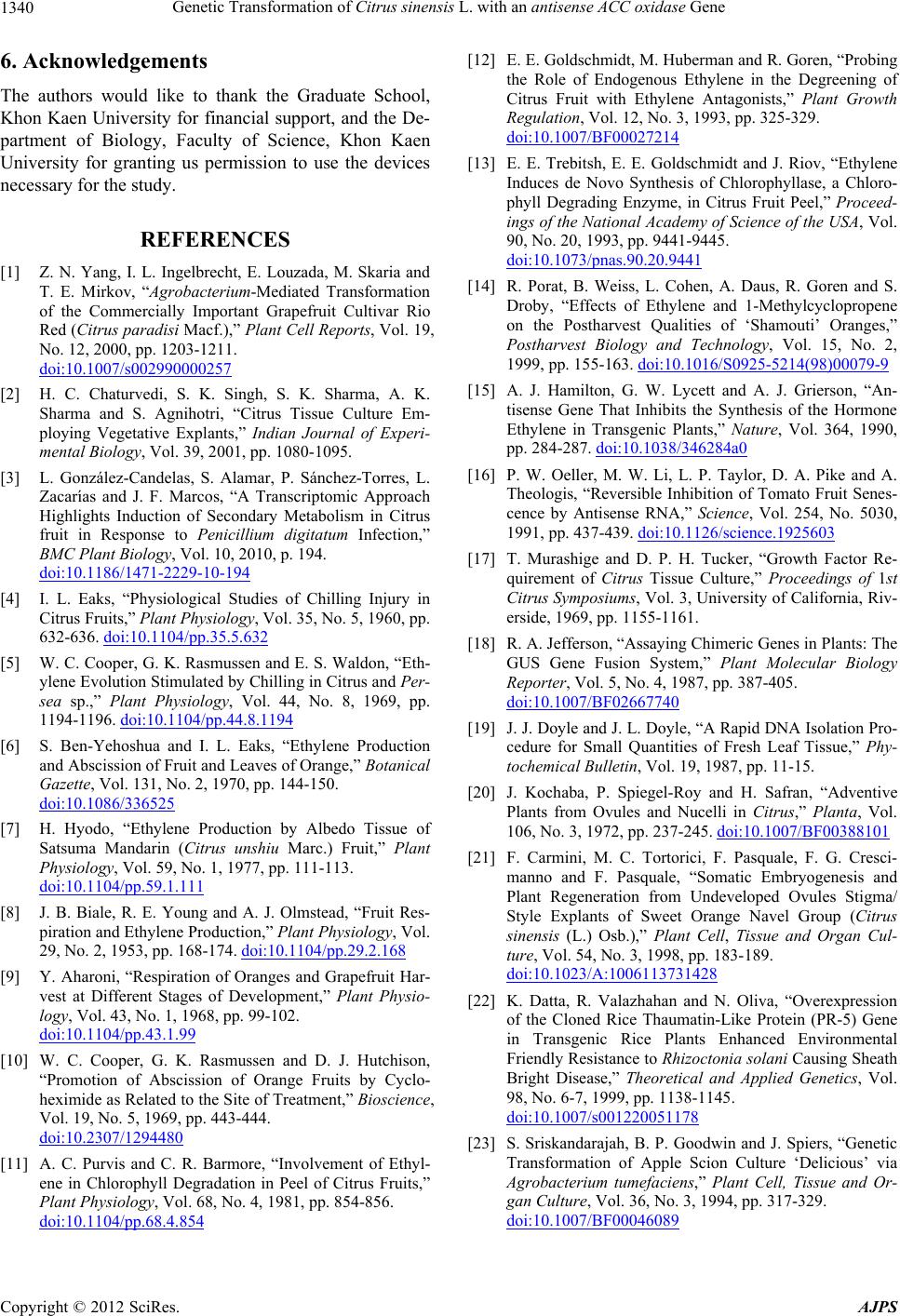
Genetic Transformation of Citrus sinensis L. with an antisense ACC oxidase Gene
Copyright © 2012 SciRes. AJPS
1340
6. Acknowledgements
The authors would like to thank the Graduate School,
Khon Kaen University for financial support, and the De-
partment of Biology, Faculty of Science, Khon Kaen
University for granting us permission to use the devices
necessary for the study.
REFERENCES
[1] Z. N. Yang, I. L. Ingelbrecht, E. Louzada, M. Skaria and
T. E. Mirkov, “Agrobacterium-Mediated Transformation
of the Commercially Important Grapefruit Cultivar Rio
Red (Citrus paradisi Macf.),” Plant Cell Reports, Vol. 19,
No. 12, 2000, pp. 1203-1211.
doi:10.1007/s002990000257
[2] H. C. Chaturvedi, S. K. Singh, S. K. Sharma, A. K.
Sharma and S. Agnihotri, “Citrus Tissue Culture Em-
ploying Vegetative Explants,” Indian Journal of Experi-
mental Biology, Vol. 39, 2001, pp. 1080-1095.
[3] L. González-Candelas, S. Alamar, P. Sánchez-Torres, L.
Zacarías and J. F. Marcos, “A Transcriptomic Approach
Highlights Induction of Secondary Metabolism in Citrus
fruit in Response to Penicillium digitatum Infection,”
BMC Plant Biology, Vol. 10, 2010, p. 194.
doi:10.1186/1471-2229-10-194
[4] I. L. Eaks, “Physiological Studies of Chilling Injury in
Citrus Fruits,” Plant Physiology, Vol. 35, No. 5, 1960, pp.
632-636. doi:10.1104/pp.35.5.632
[5] W. C. Cooper, G. K. Rasmussen and E. S. Waldon, “Eth-
ylene Evolution Stimulated by Chilling in Citrus and Per-
sea sp.,” Plant Physiology, Vol. 44, No. 8, 1969, pp.
1194-1196. doi:10.1104/pp.44.8.1194
[6] S. Ben-Yehoshua and I. L. Eaks, “Ethylene Production
and Abscission of Fruit and Leaves of Orange,” Botanical
Gazette, Vol. 131, No. 2, 1970, pp. 144-150.
doi:10.1086/336525
[7] H. Hyodo, “Ethylene Production by Albedo Tissue of
Satsuma Mandarin (Citrus unshiu Marc.) Fruit,” Plant
Physiology, Vol. 59, No. 1, 1977, pp. 111-113.
doi:10.1104/pp.59.1.111
[8] J. B. Biale, R. E. Young and A. J. Olmstead, “Fruit Res-
piration and Ethylene Production,” Plant Physiology, Vol.
29, No. 2, 1953, pp. 168-174. doi:10.1104/pp.29.2.168
[9] Y. Aharoni, “Respiration of Oranges and Grapefruit Har-
vest at Different Stages of Development,” Plant Physio-
logy, Vol. 43, No. 1, 1968, pp. 99-102.
doi:10.1104/pp.43.1.99
[10] W. C. Cooper, G. K. Rasmussen and D. J. Hutchison,
“Promotion of Abscission of Orange Fruits by Cyclo-
heximide as Related to the Site of Treatment,” Bioscience,
Vol. 19, No. 5, 1969, pp. 443-444.
doi:10.2307/1294480
[11] A. C. Purvis and C. R. Barmore, “Involvement of Ethyl-
ene in Chlorophyll Degradation in Peel of Citrus Fruits,”
Plant Physiology, Vol. 68, No. 4, 1981, pp. 854-856.
doi:10.1104/pp.68.4.854
[12] E. E. Goldschmidt, M. Huberman and R. Goren, “Probing
the Role of Endogenous Ethylene in the Degreening of
Citrus Fruit with Ethylene Antagonists,” Plant Growth
Regulation, Vol. 12, No. 3, 1993, pp. 325-329.
doi:10.1007/BF00027214
[13] E. E. Trebitsh, E. E. Goldschmidt and J. Riov, “Ethylene
Induces de Novo Synthesis of Chlorophyllase, a Chloro-
phyll Degrading Enzyme, in Citrus Fruit Peel,” Proceed-
ings of the National Academy of Science of the USA, Vol.
90, No. 20, 1993, pp. 9441-9445.
doi:10.1073/pnas.90.20.9441
[14] R. Porat, B. Weiss, L. Cohen, A. Daus, R. Goren and S.
Droby, “Effects of Ethylene and 1-Methylcyclopropene
on the Postharvest Qualities of ‘Shamouti’ Oranges,”
Postharvest Biology and Technology, Vol. 15, No. 2,
1999, pp. 155-163. doi:10.1016/S0925-5214(98)00079-9
[15] A. J. Hamilton, G. W. Lycett and A. J. Grierson, “An-
tisense Gene That Inhibits the Synthesis of the Hormone
Ethylene in Transgenic Plants,” Nature, Vol. 364, 1990,
pp. 284-287. doi:10.1038/346284a0
[16] P. W. Oeller, M. W. Li, L. P. Taylor, D. A. Pike and A.
Theologis, “Reversible Inhibition of Tomato Fruit Senes-
cence by Antisense RNA,” Science, Vol. 254, No. 5030,
1991, pp. 437-439. doi:10.1126/science.1925603
[17] T. Murashige and D. P. H. Tucker, “Growth Factor Re-
quirement of Citrus Tissue Culture,” Proceedings of 1st
Citrus Symposiums, Vol. 3, University of California, Riv-
erside, 1969, pp. 1155-1161.
[18] R. A. Jefferson, “Assaying Chimeric Genes in Plants: The
GUS Gene Fusion System,” Plant Molecular Biology
Reporter, Vol. 5, No. 4, 1987, pp. 387-405.
doi:10.1007/BF02667740
[19] J. J. Doyle and J. L. Doyl e, “A Rapid DNA Isolation Pro-
cedure for Small Quantities of Fresh Leaf Tissue,” Phy-
tochemical Bulletin , Vol. 19, 1987, pp. 11-15.
[20] J. Kochaba, P. Spiegel-Roy and H. Safran, “Adventive
Plants from Ovules and Nucelli in Citrus,” Planta, Vol.
106, No. 3, 1972, pp. 237-245. doi:10.1007/BF00388101
[21] F. Carmini, M. C. Tortorici, F. Pasquale, F. G. Cresci-
manno and F. Pasquale, “Somatic Embryogenesis and
Plant Regeneration from Undeveloped Ovules Stigma/
Style Explants of Sweet Orange Navel Group (Citrus
sinensis (L.) Osb.),” Plant Cell, Tissue and Organ Cul-
ture, Vol. 54, No. 3, 1998, pp. 183-189.
doi:10.1023/A:1006113731428
[22] K. Datta, R. Valazhahan and N. Oliva, “Overexpression
of the Cloned Rice Thaumatin-Like Protein (PR-5) Gene
in Transgenic Rice Plants Enhanced Environmental
Friendly Resistance to Rhizoctonia solani Causing Sheath
Bright Disease,” Theoretical and Applied Genetics, Vol.
98, No. 6-7, 1999, pp. 1138-1145.
doi:10.1007/s001220051178
[23] S. Sriskandarajah, B. P. Goodwin and J. Spiers, “Genetic
Transformation of Apple Scion Culture ‘Delicious’ via
Agrobacterium tumefaciens,” Plant Cell, Tissue and Or-
gan Culture, Vol. 36, No. 3, 1994, pp. 317-329.
doi:10.1007/BF00046089